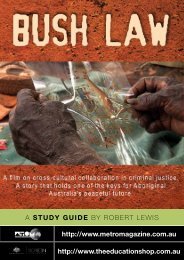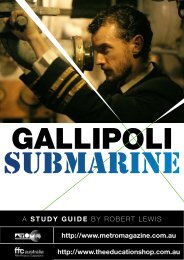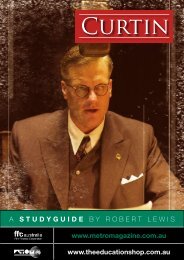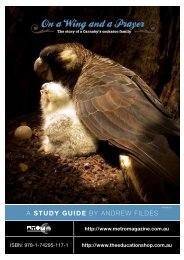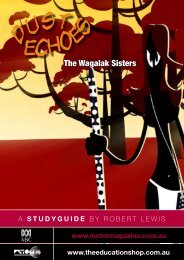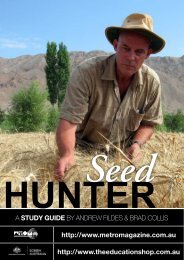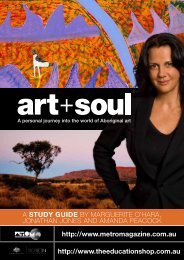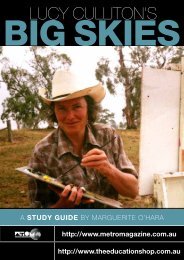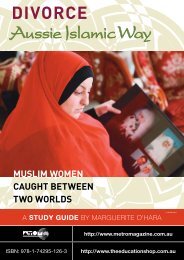ABC Education TV Series for 6-8 year olds - ABC Commercial
ABC Education TV Series for 6-8 year olds - ABC Commercial
ABC Education TV Series for 6-8 year olds - ABC Commercial
You also want an ePaper? Increase the reach of your titles
YUMPU automatically turns print PDFs into web optimized ePapers that Google loves.
as seen on<br />
<strong>ABC</strong> <strong>TV</strong><br />
<strong>ABC</strong> <strong>Education</strong> <strong>TV</strong> <strong>Series</strong><br />
<strong>for</strong> 6-8 <strong>year</strong> <strong>olds</strong>
FOR THE JUNIORS<br />
For The Juniors is a program <strong>for</strong> students aged 6-8 <strong>year</strong>s<br />
and aims to stimulate children’s curiosity and imagination;<br />
widen their horizons and encourage them to explore their<br />
environment; present enjoyable experiences which relate<br />
broadly to the lives and interests of the children; and raise<br />
issues which affect 6-8 <strong>year</strong> <strong>olds</strong>. Each series is arranged<br />
in groups of programs relating to a particular theme.<br />
Excellent educational resources are provided online.<br />
FOR THE JUNIORS <strong>Series</strong> and episodes (alpha order)<br />
1. BODY PARTS<br />
2. BUILDINGS<br />
3. CELEBRATIONS<br />
4. COMMON SENSES<br />
5. FAMILIES<br />
6. FARM TO TABLE<br />
7. FOOD<br />
8. FRIENDSHIP<br />
9. HUMAN BODY, THE<br />
10. MINIBEASTS<br />
11. PEOPLE WHO HELP US<br />
12. SAFETY<br />
13. SEA, THE<br />
14. SPACE<br />
15. TRANSPORT<br />
16. WEATHER<br />
17. WORKING ANIMALS<br />
Each series is arranged in groups of programs relating to a<br />
particular theme. The material has been developed using<br />
National and State curricula to help teachers and carers<br />
integrate the programs and activities into the classroom. See<br />
www.abc.net.au/juniors <strong>for</strong> resource materials and activities.<br />
PRODUCED BY<br />
<strong>ABC</strong> EDUCATION<br />
TELEVISION, FOR<br />
SCHOOLS. © 1990-2003<br />
www.abc.net.au/juniors
BODY PARTS (1989)<br />
3 X 15 MINS<br />
Looks at different parts of the body.<br />
1. HANDS: Shows children in an art<br />
class using their hands in many different<br />
ways, extending to adults handling<br />
vegetables, plus a look at potters and<br />
carpenters.<br />
2. FEET: Highlights what people can do<br />
with trained footwork and the different<br />
ways animals use their feet to move<br />
around.<br />
3. MOUTHS: We look at some of the<br />
extraordinary ways in which we use our<br />
mouths.<br />
BUILDINGS (2001)<br />
5 X 15 MINS<br />
Looks at the ways in which buildings<br />
are designed <strong>for</strong> specific purposes.<br />
Taking a technology perspective, each<br />
program identifies the reasons behind a<br />
building’s design. Everything from the<br />
choice of materials to safety considerations<br />
and the need <strong>for</strong> designs to assist<br />
people with disabilities is taken into<br />
account. A young girl with a curious toy<br />
that comes to life and seeks answers to<br />
questions children might ask, features<br />
in four of the five programs.<br />
1. BUILDING A HOUSE: This program<br />
begins with a montage of the many and<br />
varied houses people build and looks at<br />
special design features needed in a<br />
home <strong>for</strong> someone in a wheelchair and<br />
<strong>for</strong> a family living in the tropics. Housing<br />
of the past is also examined with a visit<br />
to a restored 19th century miner’s<br />
cottage. Running through the program<br />
is the construction of a house, from<br />
plans on paper to bricks and mortar.<br />
A young boy helps to keep us in<strong>for</strong>med<br />
about his new home’s progress.<br />
2. SHOPPING CENTRE: From facilities<br />
<strong>for</strong> delivering goods to features that<br />
make cleaning easier, this program<br />
shows how a well designed shopping<br />
centre meets the needs of people who<br />
use it. The program opens with a young<br />
girl and her father visiting a major<br />
shopping centre <strong>for</strong> the first time and<br />
explores how the centre’s architects<br />
took many things into account as they<br />
began the design process, such as fire<br />
safety features, facilities that help people<br />
in wheelchairs, the value of signs and<br />
maps and the deliberate use of certain<br />
building materials. In<strong>for</strong>mation is<br />
delivered through conversation<br />
between the narrator and the girl’s<br />
inquisitive toy, which comes to life after<br />
being accidentally left behind in a<br />
supermarket.<br />
3. HOSPITAL: A young girl finds herself<br />
in an ambulance going to a hospital<br />
after falling from a tree-house. Her<br />
favourite toy goes with her as she has<br />
an X-ray and then spends the night in<br />
the children’s ward. Along the way her<br />
toy comes to life and tours the hospital<br />
learning about facilities <strong>for</strong> gathering<br />
and storing patient in<strong>for</strong>mation, equipment<br />
used in a hospital kitchen, features<br />
that help prevent the spread of germs<br />
2
and features that assist patient movement<br />
around the hospital. It’s not just<br />
the people who work in a hospital but<br />
also the design of the building that<br />
helps with the care of hospital patients.<br />
4. TALL BUILDINGS: Explores the<br />
reasons why we have tall buildings and<br />
some of the problems architects need<br />
to solve when designing structures that<br />
go up instead of out. A young girl living<br />
in an apartment block demonstrates<br />
how a garbage chute works and the<br />
use of a security intercom system when<br />
visitors arrive. Her toy comes to life and<br />
explores other parts of the building,<br />
from the underground car-park to the<br />
rooftop. The toy’s curiosity leads us to<br />
the construction site of a multi-storey<br />
apartment block and, with the help of<br />
graphics, learns what makes the<br />
structure strong. The program concludes<br />
with the girl telling us some<br />
reasons she enjoys living up high.<br />
5. HOMES ON THE MOVE: Begins<br />
with a family on a camping holiday and<br />
then continues to explore different<br />
types of accommodation people use<br />
when they are on the move, such as<br />
swags <strong>for</strong> stockmen and shelters built<br />
by nomadic people. The program joins<br />
a couple travelling around Australia in a<br />
caravan, takes us on a horse-drawn<br />
gypsy caravan plodding a country trail<br />
and looks at a houseboat cruising<br />
along the River Murray. It concludes<br />
with the central family packing up<br />
camp and ensuring they leave nothing<br />
but footprints.<br />
CELEBRATIONS (1998)<br />
6 X 15MINS<br />
1. BIRTHDAYS: Using a young girl’s<br />
birthday party preparations as a narrative<br />
base this program explores ways in<br />
which different cultures celebrate<br />
birthdays. The concept of birthdays<br />
is extended with segments on a 100th<br />
birthday party and a school centenary<br />
celebration.<br />
2. WEDDINGS: Explores the symbols<br />
within wedding rituals and illustrates<br />
the cultural diversity in the way wedding<br />
ceremonies are celebrated. Uniting<br />
church, Hindu, Greek Orthodox and<br />
Civil weddings in this program illustrate<br />
that marriage is a special celebration<br />
and an important life event.<br />
3. CHRISTMAS: Through the windows<br />
of a young boy’s Advent Calendar this<br />
program explores the traditions and<br />
rituals of Christmas celebrations. We<br />
see different Christmas foods being<br />
prepared and see of the story of<br />
Christmas portrayed in a school’s<br />
Nativity play. The program shows<br />
common Christmas activities such as<br />
decorating Christmas tree, writing a<br />
note to Santa Claus and attending a<br />
Christmas pageant.<br />
4. NEW YEAR: This program opens<br />
with the countdown to the end of<br />
another <strong>year</strong>, graphics are used to<br />
explain the concept of one <strong>year</strong> ending<br />
and another beginning. Segments<br />
detailing the rituals and traditions of a<br />
Jewish and Chinese New Year showing<br />
3
the viewers that not all people celebrate<br />
a new <strong>year</strong> at the same time.<br />
The New Episodes are:<br />
5. CELEBRATING A NEW BABY:<br />
People often celebrate the birth of a<br />
new baby in their family. We share in<br />
the thoughts of a young boy as he<br />
walks through a hospital to meet his<br />
new baby sister <strong>for</strong> the first time. Later<br />
we join his family as they bring their<br />
new baby home. We see how some<br />
different cultures celebrate the arrival of<br />
a new baby, from Vietnamese prayers<br />
and feasting, to a Catholic christening<br />
in a church. The common thread to all<br />
these celebrations is that they all share<br />
the same purpose - to welcome a baby<br />
into a wider community of people who<br />
will share in his / her life.<br />
6. CELEBRATING ACHIEVEMENTS:<br />
Achievements are defined as happy<br />
events that can take place both in<br />
private and public settings. The planning,<br />
preparation and staging of a<br />
Year Seven graduation party is woven<br />
throughout this program. The importance<br />
of recognising and celebrating an<br />
individual’s achievements is explained<br />
as we see celebrations ranging from a<br />
police graduation parade to the presentation<br />
of cub badges and a schools’<br />
environment award.<br />
COMMON SENSES (1989)<br />
5 X 15MINS<br />
Each of the programs follows a standard<br />
<strong>for</strong>mat, rather like a comic annual or a<br />
“Ripping Yarns” type omnibus.<br />
1. TASTE: Explorer segment. A<br />
sequence using special effects and an<br />
adventurous story to conduct an<br />
expedition around the geography and<br />
topography of human sensory organs.<br />
This segment is presented so that the<br />
identity of the organ is gradually<br />
revealed, both to the explorers and to<br />
the audience.<br />
2. SMELL: Sense song. The words<br />
of the song pose questions about<br />
each of the senses and the pictures<br />
show animals using those senses. By<br />
observing animals, we see the senses<br />
as survival tools.<br />
3. SIGHT: A world without... A segment<br />
which examines the implications of living<br />
without the use of each of the senses.<br />
4. HEARING: Hugh B. Aware: Private<br />
Investigator. In each program Hugh<br />
must solve a problem but the clues<br />
involve only one sense. In smell, <strong>for</strong><br />
instance, all clues relate to the nose<br />
alone.<br />
5. TOUCH: A montage of the different<br />
human sensory organs, showing how<br />
they move; the ways we use them; the<br />
ways they help us.<br />
FAMILIES (1990)<br />
3 X 20MINS<br />
1. WHERE I LIVE: Cassandra is 8 <strong>year</strong>s<br />
old and has two families. She spends<br />
most of her time with her father, her<br />
brother, her stepmother and her three<br />
4
step sisters. She also spends some of<br />
the time living with her mother. The<br />
program explores the themes of where<br />
people live, who they live with and the<br />
way living arrangements change.<br />
2. COOPERATION: Catherine is 8<br />
<strong>year</strong>s old and lives with her mother, her<br />
father and her two sisters. The focus in<br />
this program is on cooperation in family<br />
life, the way in which each member of<br />
the family contributes to the smooth<br />
running of the household - and how in<br />
varying degrees, everyone is responsible<br />
<strong>for</strong> the well-being and safety of the<br />
others. It raises gender issues because<br />
it is Catherine’s mother who goes to<br />
work while her father looks after the<br />
house and children.<br />
3. BELONGING: Nathan is 8 <strong>year</strong>s old<br />
and lives with his brother and mother.<br />
We observe everyday life with this<br />
family, concentrating on how his mother,<br />
as a single parent, manages the household<br />
and spends time with her children.<br />
We see the many facets of belonging<br />
that are so important in family life.<br />
We also demonstrate the way in which<br />
members of the extended family play a<br />
significant role in developing the sense<br />
of belonging.<br />
FARM TO TABLE (2001)<br />
6 X 15 MINS<br />
How many children believe that food<br />
comes from the supermarket? This<br />
series of six programs looks at what<br />
happens to certain foods be<strong>for</strong>e they<br />
reach the supermarket shelves. Each<br />
program features a cartoon animal that<br />
prompts children to question or ponder<br />
the issues raised.<br />
1. MILK: Shows how milk gets from the<br />
cow to the table. To produce milk cows<br />
need lush green grass and a calf, as<br />
they produce milk as food <strong>for</strong> their<br />
calves. While the calves are drinking<br />
their mother’s milk the cow continues to<br />
produce milk. Dairy farmers take the<br />
calves away but milk the cows so the<br />
cows bodies thinks they are still feeding<br />
their calves, but they are really producing<br />
milk <strong>for</strong> the farmer to sell. The program<br />
shows how the farmer milks his cows<br />
and how it is then pasteurised and<br />
homogenised be<strong>for</strong>e being put into<br />
containers ready <strong>for</strong> sale.<br />
2. HONEY: Why doesn’t all honey look<br />
and taste the same? Where does<br />
honey come from? Why do bees make<br />
honey? The program looks at how bees<br />
live in communities in which every bee<br />
has a very special job to do. The queen<br />
is in charge and other bees make sure<br />
she is well looked after and that her<br />
eggs and her young bees are also well<br />
cared <strong>for</strong>. Some of the worker bees go<br />
out to collect nectar from flowers and<br />
when they return other worker bees<br />
turn it into honey and store it in the<br />
honey comb. This is food <strong>for</strong> the colony<br />
when there are no flowers around. Bee<br />
keepers - apiarists - collect this stored<br />
honey, separate it from the honey comb<br />
and sell it. The program also looks at<br />
how apiarists farm their bees.<br />
5
3. APPLES: In a school playground,<br />
children eat and talk about apples and<br />
various apple products. Why do apple<br />
trees grow apples? It all starts with the<br />
honey bee. Two children living on an<br />
apple orchard – along with their dog –<br />
demonstrate what’s involved in growing<br />
apple trees. What do they need in order<br />
to grow? How are they harvested?<br />
Follow the apples to the markets. Learn<br />
how fresh apples are processed into<br />
apple juice and apple cider vinegar.<br />
This program features a friendly cartoon<br />
fruit bat.<br />
4. RICE: A rice farmer and his children<br />
show how they grow rice: from land<br />
preparation, irrigation, sowing seeds, to<br />
harvesting the crop. Why is rice milled?<br />
What’s the difference between brown<br />
and white rice? While a father and son<br />
are shopping at the supermarket we<br />
show various rice products and how we<br />
eat them in our multicultural society.<br />
Children also talk about their favourite<br />
rice dish. This program features a<br />
cartoon frog that lives in the rice field.<br />
5. BREAD: Where does bread come<br />
from? This is the question asked while<br />
children eat their sandwiches in the<br />
school playground. A cartoon galah<br />
flies to the wheat fields to introduce the<br />
wheat crop. Watch the crop being<br />
planted and looked after by the farmer<br />
until it is finally harvested. Visit the flour<br />
mill and learn why wheat is milled into<br />
flour. How do you make bread? This<br />
program explores the processes from<br />
the factory production line to the small<br />
scale local bakery to a mother and<br />
daughter making bread at home. What<br />
sorts of bread do we eat in our multicultural<br />
society? The children in the<br />
school playground talk about their<br />
favourite breads.<br />
6. FISH: How do fish get from the sea<br />
to our table? Watch a commercial<br />
fishing vessel at work and visit the fish<br />
markets. Follow particular fish species<br />
from the markets to the shops and<br />
finally to the table. Discover the different<br />
ways to eat fish in our multicultural<br />
society. What’s a tuna farm? How is<br />
tuna canned? A father and son go fishing<br />
and return home later with a surprise.<br />
This program also features a cartoon<br />
pelican that likes going fishing too.<br />
FOOD (1997)<br />
4 X 15 MINS<br />
1. PACKAGING FOOD: This program<br />
poses the question - why do we package<br />
food? It begins with an historical<br />
shopping trip where food is purchased<br />
without the modern food packaging<br />
convenience we have today. It explores<br />
how packaging helps to protect our<br />
food, prevents contamination and helps<br />
keep food fresh. One of the many<br />
places we visit is a big commercial<br />
bakery where we see how biscuits are<br />
packaged to ensure they get to us<br />
unbroken. We also explore how packaging<br />
can make food easier to use. The<br />
program also looks at how we can help<br />
6
the environment by looking at ways of<br />
recycling and reusing some different<br />
types of packaging.<br />
2. KEEPING FOOD: Once we’ve<br />
bought our food - how do we keep it<br />
fresh? This program examines a range<br />
of practical ways we can keep food<br />
from deteriorating. We see where fresh<br />
food comes from and explore ways of<br />
recognising fresh or spoilt food, using<br />
our senses. The program shows the<br />
effects of exposing food to moisture<br />
and air. It then demonstrates some<br />
processes of keeping food, including<br />
freezing, canning and drying.<br />
3. COOKING FOOD: Explores the<br />
reasons why we cook food and the<br />
ways food changes when cooked. It<br />
looks at the evolution of cooking -<br />
taking us from early campfires through<br />
to the wonder of microwave ovens in a<br />
home kitchen. We see how meals are<br />
prepared on a large-scale in a commercial<br />
kitchen. Children are encouraged to<br />
experiment with cooking by seeing their<br />
peers busy in the kitchen.<br />
4. EATING FOOD: a celebration of the<br />
wide variety of food available. It examines<br />
why we need to eat and what happens<br />
to food when we eat it. A comparison<br />
between healthy and unhealthy foods<br />
encourages children to make sensible<br />
choices. Cultural differences in what we<br />
eat are explored. The program also<br />
looks why and how different foods have<br />
become available in Australia.<br />
FRIENDSHIP (1990)<br />
3 X 15MINS<br />
A dramatised series which raises a<br />
variety of personal issues to do with<br />
friendship. The same set of characters<br />
is used in each of the programs, yet<br />
each program is self contained.<br />
1. MAKING FRIENDS: The Weatherly<br />
family is moving house, so Liam, an<br />
only child, is confronted with the<br />
problem of leaving old friends and<br />
making new ones.<br />
Liam also has to face the difficulties of<br />
going to a new school. He doesn’t like<br />
the new house as much as the old one.<br />
Things are made worse when his first<br />
day at school goes wrong. But friendly<br />
advice comes from an unexpected<br />
direction. He’s helped by the next door<br />
neighbour, a middle aged woman, who<br />
Liam thinks is a bit strange.<br />
Things look up when Liam finds out<br />
Andrew, a boy from his class, lives<br />
across the road.<br />
2. LOSING FRIENDS: (WARNING This<br />
program deals with the topic of death.<br />
Teachers may choose to preview and<br />
do more pre-program preparation than<br />
usual.) Gus, Liam’s best friend from his<br />
old school, comes to stay at Liam’s<br />
house <strong>for</strong> the first time.<br />
Liam introduces Gus to Andrew, his<br />
new friend. They don’t get on. For Liam<br />
and Gus, things have changed. After<br />
three months apart from each other,<br />
7
they don’t have much to say. It just isn’t<br />
the same as it used to be. Gus goes<br />
home, and Liam plays with Andrew.<br />
Liam is called home. He knows<br />
something is wrong. His dog, Mog, has<br />
been run over and killed. Liam is<br />
shocked. The next day he stays home<br />
from school keeping to his room and<br />
speaking to no-one.<br />
Again, help comes from an unexpected<br />
direction. Mrs Doran, the woman from<br />
next door, has experienced the loss of<br />
pets herself and understands how Liam<br />
feels.<br />
3. KEEPING FRIENDS: Andrew comes<br />
to stay with Liam overnight. They have<br />
a great time and get on extremely well.<br />
So well in fact that Liam lets Andrew in<br />
on his great secret. Liam has a collection<br />
of soft toys, which he keeps hidden in<br />
the bottom of his wardrobe. These toys<br />
are his secret friends and he talks to<br />
them. They all have names. The boss of<br />
the soft toys is Bunt, the big teddy.<br />
Andrew is interested in the soft toys.<br />
The next day, after Andrew has gone<br />
home, Liam discovers that Bunt is<br />
missing. Liam remembers Andrew’s<br />
interest and suspects that Andrew has<br />
taken Bunt. He asks Andrew whether<br />
he has seen Bunt and Andrew’s reply<br />
makes him suspicious.<br />
At school the following day, Liam tells<br />
one of the other kids that he thinks<br />
Andrew is a thief. Andrew hears about<br />
this and is furious. In front of a large<br />
group of children in the playground,<br />
he reveals the secret of Liam’s soft toy<br />
collection.<br />
Liam goes home, to discover that his<br />
mother has found Bunt among the<br />
sheets in the laundry basket. He wasn’t<br />
stolen after all. Liam now has to sort<br />
out the situation with Andrew.<br />
THE HUMAN BODY (2001)<br />
4 X 15MINS<br />
1. THE WORKING BODY: Follows the<br />
morning routine of a young boy, and<br />
looks at how his body works as a<br />
system. He uses his muscles and<br />
bones to get out of bed, and as he<br />
yawns, the program explains how his<br />
lungs, blood and heart work. As he eats<br />
his breakfast the program looks at his<br />
digestive system and introduces his<br />
brain as the control centre of the body<br />
to make all these things happen.<br />
*WINNER* SILVER WORLD MEDAL<br />
IN THE EDUCATIONAL/INSTRUCTIONAL<br />
ELEMENTARY CATEGORY OF THE 2002 NEW<br />
YORK FESTIVAL.<br />
2. THE THINKING/FEELING BODY:<br />
*The five senses are our contact with<br />
the world and can protect us from<br />
danger - just like animals. Not everyone<br />
has five senses. The program looks at<br />
how blind and deaf children can use<br />
their other senses to compensate. This<br />
program introduces how our brain<br />
receives messages from our senses and<br />
computes them, then sends messages<br />
back to our body to tell it what to do.<br />
8
Our brain also processes and stores the<br />
things we see hear, touch, taste, and<br />
smell and that’s how we learn new things.<br />
3. USING YOUR BODY: Focuses on<br />
the body in action using its skeleton<br />
and muscles from babyhood to old<br />
age. Our skeleton has joints so we can<br />
move our body into different shapes,<br />
but it needs muscles to make it move.<br />
Children with physical disabilities<br />
participate in sport and dance activities.<br />
Everybody needs exercise to keep their<br />
muscle strong to support their bones.<br />
We can all move our muscles and bone<br />
to do a variety of physical activities, but<br />
we’re not good at everything - and<br />
that’s what makes us different.<br />
4. LOOKING AFTER YOUR BODY:<br />
Why does our body need oxygen, food<br />
and water to stay alive? Our body has<br />
some of its own ways to look after itself,<br />
but we need to look after our body as<br />
we grow and get old. This includes<br />
giving it healthy food, exercise to make<br />
our heart muscles strong, wearing<br />
appropriate clothing <strong>for</strong> the seasons to<br />
keep us warm, cool or dry and protecting<br />
our skin from the sun. What do we do<br />
everyday to look after our body.<br />
MINIBEASTS<br />
ENVIRONMENTS (1987)<br />
4 X 15MINS<br />
Looks at a different environment: caves,<br />
a bush pond, a city and a beach. The<br />
programs present each of the environments<br />
as a home in which minibeasts<br />
interact with other life <strong>for</strong>ms and<br />
cope with different sets of conditions.<br />
Minibeast Environments has been<br />
designed to allow children to observe<br />
the programs and to draw conclusions<br />
<strong>for</strong> themselves.<br />
1. CAVES: Not only are two cave<br />
environments looked at in this program,<br />
but also the rain<strong>for</strong>ests outside the<br />
wilderness cave and the tourist cave.<br />
2. BUSH POND: An old quarry that fills<br />
with rainwater is only a few hundred<br />
metres away from a city suburb. Very<br />
few stop to look closely at the amazing<br />
variety of minibeast life that lives<br />
around, in and on the pond.<br />
3. CITY: It may appear, at first, that this<br />
program is about a guy and two girls<br />
who rent an old house in an old suburb.<br />
But the program revolves around the<br />
lives of the many minibeasts who also<br />
live there. The hall spider, the kitchen<br />
cockroach, the bedroom beetle, the<br />
bathroom scorpion and the house<br />
centipede, to name just a few, are very<br />
com<strong>for</strong>table in such a place.<br />
4. BEACH: A beach is a place where<br />
humans can go to enjoy themselves; to<br />
swim, to sunbake, to play games. But<br />
it’s also a home to many tiny creatures,<br />
most of which we never notice. They<br />
live in and on the sand, in rock pools, in<br />
the water and in the fringe of bush at<br />
the back of the beach. The program<br />
looks at the variety of life that inhabits<br />
the ‘miniworlds’ that can be found on<br />
any beach.<br />
9
PEOPLE WHO HELP US<br />
(1997)<br />
4 X 15 MINS<br />
Looks at people who help us: why<br />
we all need help from others at certain<br />
times, who helps us, why these people<br />
are in a position to help us, what<br />
<strong>for</strong>ms that help can take, and ways to<br />
approach these people <strong>for</strong> help. The<br />
programs will also examine each<br />
individual’s responsibility to help<br />
themselves and others.<br />
1. PEOPLE WHO HELP US WITH<br />
OUR HEALTH: By demystifying the<br />
role of health workers, this program<br />
aims to reassure children and inspire<br />
them to take an active interest in their<br />
own wellbeing.<br />
2. PEOPLE WHO HELP US WITH<br />
OUR SAFETY: The program stresses<br />
that safety is everyone’s responsibility,<br />
whether through safe work and play<br />
practises or through simply obeying<br />
rules.<br />
3. PEOPLE WHO HELP US WITH<br />
OUR ENVIRONMENT: Who keeps our<br />
parks green, our streets clean and our<br />
rubbish collected and recycled? This<br />
program shows children that they are<br />
not alone in their attempts to look after<br />
planet earth.<br />
4. PEOPLE WHO HELP US WITH<br />
TRANSPORT: This program looks at<br />
the wide variety of people who help us<br />
to make that journey, from taxi and bus<br />
drivers to ferry and jumbo jet pilots and<br />
also explains the responsibilities and<br />
skills involved in transporting people<br />
and investigates the special needs of<br />
and facilities provided <strong>for</strong> people with<br />
disabilities.<br />
SAFETY (1990)<br />
4 X 15MINS<br />
Looks at various aspects of personal<br />
safety. Each program emphasises the<br />
need <strong>for</strong> hazard identification skills and<br />
the use of observation and intelligence<br />
in the identification, avoidance and<br />
prevention of accidents. The programs<br />
avoid showing accidents but instead<br />
present situations which the audience<br />
can analyse <strong>for</strong> itself, with guidance<br />
from the program’s presenter.<br />
1. AS SAFE AS HOUSES: This program<br />
opens with the proposition that houses<br />
are not necessarily as safe as they<br />
seem, taking a look at a child’s bedroom,<br />
the bathroom and the kitchen. It looks at<br />
the question of accident prevention, and<br />
raises the issue of the safety of younger<br />
brothers and sisters.<br />
2. PLAY IT SAFETY: This program<br />
takes us out of the house and into the<br />
suburban backyard or garden. It looks<br />
at hazards that can exist in apparently<br />
harmless environments like the lawn,<br />
the vegetable garden and the garden<br />
shed. Again it emphasises the need <strong>for</strong><br />
hazard identification skills.<br />
3. TRAVEL SAFETY: This program<br />
looks at road safety from the point of<br />
view of the child. It emphasises the<br />
10
constant need to use our senses<br />
and intelligence to identify and avoid<br />
hazardous situations.<br />
4. WATER SAFE: This program has<br />
been designed to complement and<br />
con<strong>for</strong>m with the RLSSA Aquacode<br />
program and deals with pool safety,<br />
creek and beach safety, and include<br />
advice on sunburn protection.<br />
THE SEA (2003)<br />
4 X 15 MINS<br />
Aims to increase an understanding<br />
and appreciation of various aspects of<br />
the sea.<br />
Different shorelines and depths of the<br />
sea are examined as places to have<br />
fun, as places to find food, and as<br />
places which support a great diversity<br />
of life that has adapted to the different<br />
environments.<br />
1. Under the Sea: Looks at<br />
• How animals breathe in water<br />
• How the sea changes as we go<br />
deeper<br />
• How people get to see what is<br />
below the surface of the sea and<br />
• Some of the plants and animals that<br />
live in the sea and how they survive<br />
All animals need to breathe, even when<br />
they are in water. Fish have gills so they<br />
can take oxygen out of the water, but a<br />
family looking at fish while floating on<br />
the top of the water, use snorkels so<br />
they can look at the plants and animals<br />
just below the surface.<br />
When people go deeper into the sea<br />
they take their own air in tanks. We see<br />
some scuba divers preparing <strong>for</strong> a dive<br />
and then diving into the sea to look at<br />
creatures that live further down below<br />
the surface of the water.<br />
But as water is heavy, people would be<br />
crushed if they went too deep. There is<br />
also no light in the deepest parts of the<br />
ocean. Special remotely operated<br />
vehicles with onboard cameras and<br />
lights are used to see some of the<br />
amazing creatures that live in the<br />
deepest darkest depths of the sea.<br />
2. Life on the Seashore: Two different<br />
seashores are explored <strong>for</strong> 2 different<br />
reasons.<br />
• Sandy sea shore<br />
Tyson, Jacoby and their family live a<br />
long way from the city, so the sandy<br />
sea shore is not only a place to play,<br />
it’s also a place where they collect<br />
food.<br />
We see how they collect lots of pipis<br />
- a small shellfish - from the shallows.<br />
Some of the pipis are then used <strong>for</strong><br />
bait to catch fish, but most are taken<br />
home and cooked <strong>for</strong> dinner.<br />
• Rock ledge<br />
Rachael and Rebekah live near a<br />
city beach and are able to explore a<br />
rock ledge with a marine biologist.<br />
We learn about many of the plants<br />
and animals that inhabit this type of<br />
seashore.<br />
However, Rachael and Rebekah learn<br />
that they must not harm or damage any<br />
11
of the plants or animals. That way they<br />
will be there <strong>for</strong> others to enjoy.<br />
3. Mangroves: Looks at how mangroves<br />
have adapted to their wet, salty, tidal<br />
environment. We find that mangroves<br />
are also essential <strong>for</strong> many creatures<br />
like prawns, crabs and fish. They grow<br />
up here as there are lots of places to<br />
hide in the tangle of roots, stems and<br />
branches. When they are bigger and<br />
stronger, they go out into the ocean. If<br />
mangroves disappeared so would many<br />
sea creatures. But <strong>for</strong> Tyson and<br />
Jacoby, mangroves are special because<br />
they are a place where they go with<br />
their dad to collect oysters, which they<br />
love to eat raw, or lightly cooked on the<br />
barbeque.<br />
4. Let’s Go to the Beach: We visit a city<br />
beach and see some of the activities<br />
that happen be<strong>for</strong>e most people arrive -<br />
rubbish collection, a beach cleaning<br />
machine in action, lifeguards checking<br />
<strong>for</strong> the safest part of beach.<br />
We meet Madelaine who is a member<br />
of the Nippers club and find out some<br />
important beach safety tips, like where<br />
to swim, how to enter the water safely<br />
and what to do if you get into difficulties<br />
in the water.<br />
We find out that even when we live a<br />
long way from the sea, we can cause it<br />
to become an unsafe place <strong>for</strong> people<br />
and sea creatures to swim. The program<br />
also looks at different waves and how<br />
waves are <strong>for</strong>med.<br />
SPACE (1998)<br />
4 X 15MINS<br />
Looks at the fascinating world above us<br />
- space. With a focus on easily identifiable<br />
objects in the day and night sky,<br />
such as the sun, moon and stars, this<br />
series links the topic of “space” with<br />
the everyday experience of young<br />
children. The series concludes with a<br />
look at space travel, including an interview<br />
with Australian astronaut Dr Andy<br />
Thomas upon his return from a stay on<br />
the Russian Mir space station.<br />
1. THE SUN: Focuses on the way in<br />
which people make use of the sum in<br />
everyday life. For example, drying the<br />
washing or paintings, ripening fruit and<br />
providing warmth so that we can enjoy<br />
outdoor activities. The use of solar power<br />
as a <strong>for</strong>m of energy is also introduced.<br />
2. THE MOON: Why does the moon<br />
shine? Why does the moon change<br />
shape? Does the moon move? How big<br />
is the moon? These and other questions<br />
are explored. This program looks<br />
at the development of our understanding<br />
of what it is like on the moon, using<br />
language and concepts appropriate to<br />
lower primary viewers. Space travel is<br />
also featured, with stories from people<br />
old enough to remember the first man<br />
walking on the moon, to children asking<br />
questions about what the moon is like.<br />
3. STARS: Have fascinated people ever<br />
since the beginning of time. In this<br />
program, students see some well<br />
12
known constellations such as the<br />
Southern Cross and the Saucepan<br />
which appear in the night sky. Using<br />
their own words, children in the program<br />
give a simple definition of a star. The<br />
program’s narrator explains that the sun<br />
is a star and that stars are suns. The<br />
reason stars are not seen in the daytime<br />
is also explained.<br />
4. SPACE TRAVEL: We meet Dr Andy<br />
Thomas, the first Australian astronaut<br />
in this program. Dr Thomas answers<br />
questions children are likely to ask<br />
about his experience travelling in space.<br />
Using footage from the space shuttle<br />
and NASA to illustrate, Dr Thomas<br />
explains how you eat, exercise, wash,<br />
clean your teeth and work in space.<br />
TRANSPORT (2000)<br />
3 X 15 MINS<br />
1. GETTING AROUND IN THE AIR:<br />
Shows different <strong>for</strong>ms of air transportation<br />
from jumbo jets, hot air balloons,<br />
gliders and helicopters. Using easily<br />
understood graphics and explanations<br />
the program shows how the aerofoil<br />
shape of the wing and the plane engine<br />
function to allow plane to take off.<br />
There is also a look behind the scenes<br />
when a jumbo is refuelled and the<br />
cargo is loaded. Two children who are<br />
taking a plane flight to spend a holiday<br />
with their father in another city, feature<br />
throughout the program.<br />
2. GETTING AROUND ON LAND:<br />
Using three central characters and their<br />
animated friend this program explores<br />
some of the different ways we get<br />
around on land, explains in simple<br />
terms how an axle and the brakes in a<br />
car work and using a simple experiment<br />
shows the reason <strong>for</strong> making car tyres<br />
from rubber.<br />
3. GETTING AROUND ON WATER:<br />
Shows a variety of ways to get around<br />
on water including Aboriginal bark<br />
canoes, sailing ships, houseboats, jet<br />
boats, yachts, ferries. It shows black<br />
and white footage of bark canoes being<br />
made and follows the making of a fibreglass<br />
boat. A young boy’s dream of<br />
finding buried treasure is a thread<br />
through the program.<br />
TWELVE DAYS OF<br />
CHRISTMAS (1996)<br />
20 MINS<br />
This program combines twelve<br />
Australian native animals as an alternative<br />
to the original Twelve Days of<br />
Christmas. The song includes<br />
an Emu, Galahs, Jabirus, Kookaburras,<br />
Kangaroos, Platypuses, Koalas,<br />
Possums, Wombats, Lizards, Numbats<br />
and Parrots. It’s a colourful and entertaining<br />
program that everyone can<br />
enjoy.<br />
13
WEATHER<br />
7 X 15 MINS<br />
1. Rain (1984)<br />
2. Sunshine (1984)<br />
3. Wind (1984)<br />
4. Wet Weather (1999)<br />
5. Cold Weather (1999)<br />
6. Hot Weather (1999)<br />
7. Dry Weather (1999)<br />
1 RAIN: The object of this program is<br />
to encourage children to use their<br />
senses to explore some of the unique<br />
experiences that come with a rainy day.<br />
2. SUNSHINE: The program investigates<br />
aspects of Sunshine that are part<br />
of a child’s world. These include the<br />
nurturing, aesthetic and dangerous<br />
qualities of the sun and its light. It follows<br />
a day in the life of a young girl, who sets<br />
out to find these things out <strong>for</strong> herself.<br />
She explores the light as it appears<br />
when reflected, diffused, and split into a<br />
rainbow. She finds that plants need sunshine<br />
to grow, and people and animals<br />
need it to keep warm. She finds objects<br />
in the sunlight cast shadows, and that<br />
our nights come when our side of the<br />
world is in shadow.<br />
3. WIND: Wind is seen in terms of its<br />
impact on the environment; driving<br />
clouds, creating waves; carrying seeds<br />
and leaves. As a means of propulsion;<br />
driving sails; lifting aeroplanes; turning<br />
the sails of windmills, and as a malevolent<br />
<strong>for</strong>ce - powering cyclones and<br />
storms, etc.<br />
4. WET WEATHER: Opens with a<br />
young boy caught in the rain on his way<br />
home. Imagine what it would be like if<br />
he wasn’t wearing appropriate wet<br />
weather clothing? Different scenarios<br />
encourage young viewers to think<br />
about how rain affects their day-to-day<br />
lives. The program explores ways to<br />
predict rain and with the help of a<br />
graphic learn about the water cycle.<br />
Successive shots showing dams, a<br />
reservoir, and a creek at different times<br />
of the <strong>year</strong>, illustrate how rain can<br />
change the water level in some places.<br />
The program also looks at the need to<br />
store, conserve and use rainwater.<br />
Finally viewers are taken through some<br />
easy steps to make a rain gauge and<br />
children tell us what they think about<br />
rainy days.<br />
5. COLD WEATHER: Filled with images<br />
to make young viewers shiver! It examines<br />
the ways we dress when it is cold<br />
and shows how some animals adapt to<br />
cold conditions through their behaviour<br />
and physical features. Successive shots<br />
of the same locations at the same time<br />
of the <strong>year</strong> illustrate the changing life<br />
cycles of trees, from green growth<br />
through to Autumn leaves and bare<br />
branches. Children in the <strong>TV</strong> program<br />
talk about the different foods they like<br />
to eat when it’s cold. Finally viewers<br />
are shown how to read and interpret<br />
temperature using a thermometer.<br />
6. HOT WEATHER: Opens with summer<br />
scenes at the beach. A weather <strong>for</strong>ecaster<br />
sets the mood and suggests<br />
14
some ways to protect skin from Sun<br />
damage. Viewers are encouraged to<br />
think about the sort of hot weather they<br />
experience - is it hot and dry, or hot<br />
and humid? Sun safety messages are<br />
practiced as we see people participate<br />
in a range of hot weather activities -<br />
both indoors and outdoors. The program<br />
examines how hot weather makes us<br />
feel and how our bodies react to it. It<br />
also looks at how some animals adapt<br />
to heat. In the closing segments we see<br />
some simple examples of how the Sun<br />
is a useful energy source.<br />
7. DRY WEATHER: After showing<br />
some familiar dry day scenarios, this<br />
<strong>TV</strong> program looks at what makes a day<br />
dry by examining the concept of low<br />
humidity. Using images of Antarctica,<br />
viewers learn that dry days aren’t<br />
necessarily hot. A young girl explains<br />
that harvesting takes place on her family’s<br />
farm during the dry months. Some<br />
selected landscapes are shown at<br />
different times of the <strong>year</strong>, illustrating<br />
how green places turn brown as rainfall<br />
drops off. Other consequences of<br />
prolonged dry weather are also illustrated,<br />
including ways in which some<br />
plants and animals have adapted to dry<br />
conditions. Finally, the program looks at<br />
some practical ways to conserve water,<br />
especially in areas of low rainfall.<br />
WORKING ANIMALS (1999)<br />
2 X 15 MINS<br />
Two new episodes of this popular series<br />
explore the lives of working animals.<br />
1. WORKING DOG: Shows children<br />
that dogs are more than household<br />
pets. It explores the working world of<br />
five different dogs and their handlers.<br />
These dogs use their specially trained<br />
skills to fulfil different roles in a range of<br />
working environments. We see how<br />
dogs and their handlers communicate<br />
and work together as a team. The<br />
program examines some rules that<br />
dogs and their handlers must obey in<br />
their places of work. It also shows how<br />
dogs can meet some basic human<br />
needs and that the relationship<br />
between owner/ handler and dog is<br />
mutual and rewarding.<br />
2. WORKING HORSE: Explores some<br />
historical and modern day work roles<br />
<strong>for</strong> horses. Four different horses are<br />
observed working with their handlers.<br />
The programs look at the physical<br />
and mental attributes of horses that<br />
help them in their work and the way<br />
handlers value their horses and communicate<br />
with them. Through the use<br />
of historic footage and photos the<br />
program looks at life be<strong>for</strong>e cars. It<br />
shows why some ways of using<br />
working horses have changed from the<br />
past to the present day, and that horses<br />
are still better than machines <strong>for</strong> some<br />
<strong>for</strong>ms of work. The program also<br />
explains and demonstrates some basic<br />
safety rules that should be observed<br />
when around horses.<br />
15
For further in<strong>for</strong>mation on this popular<br />
FOR THE JUNIORS series and invaluable<br />
classroom worksheets, activities and resources<br />
visit: www.abc.net.au/juniors<br />
Download free .pdf <strong>for</strong>mat materials using<br />
Adobe Acrobat.<br />
For a more comprehensive list<br />
of programs and educational resource available<br />
from <strong>ABC</strong> Video Program Sales extensive video<br />
collection or as seen in the School Television<br />
Service, please call our Sales Co-ordinators on<br />
1300 650 587 or browse<br />
www.abc.net.au/programsales <strong>for</strong> details.<br />
Printed in 2003 by <strong>ABC</strong> Video Program Sales<br />
Australian Broadcasting Corporation GPO Box 9994 Sydney NSW 2001 © 2003<br />
16
FOR THE JUNIORS<br />
This popular series is suitable <strong>for</strong><br />
lower primary school students.<br />
Enquiries: <strong>ABC</strong> Video Program Sales<br />
GPO Box 9994<br />
Sydney 2001<br />
Phone: 1300 650 587<br />
Fax:(02) 8833 3975<br />
www.abc.net.au/juniors<br />
www.abc.net.au/programsales



